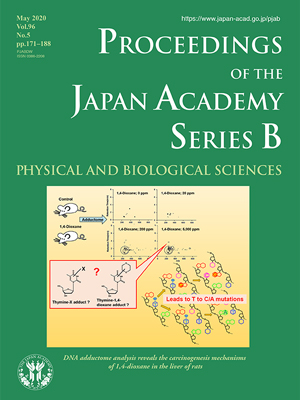About the Cover
Vol. 96 No. 5 (2020)
The DNA adductome is revealed by the next-generation comprehensive analysis of DNA adducts using liquid chromatography-mass spectrometry instruments. The amounts and types of DNA adducts related to environmental exposure to chemical compounds can be analyzed by this approach. A high-performance liquid chromatography-quadrupole time-of-flight (HPLC-QTOF) mass spectrometer (MS) provides high-resolution and accurate-MS (HRAM) analysis. Spectral data obtained by HRAM analysis is accurate and sufficient for determining the molecular formula of an ion, thereby providing confirmation of the adduct structure. The chemical structure of DNA adducts can be useful for understanding the mechanisms of genotoxicity/carcinogenicity of chemical substances. Using adductome analysis, Y. Totsuka et al. clarify the carcinogenesis mechanisms of 1,4-dioxane (in this issue, pp. 180-187).
1,4-Dioxane is a synthetic industrial chemical that is widely used as a solvent for organic products, hence, it is often found as an impurity in various consumer products, such as deodorants, shampoos, and cosmetics. Moreover, 1,4-dioxane is released into the environment during production, resulting in contamination of drinking water and food, which poses potential health concerns. This compound has been reported to induce liver cancer in rats; however, the mechanisms involved remain unclear. The in vivo genotoxicity of 1,4-dioxane was evaluated using a bacterial guanine phosphoribosyl transferase (gpt) gene integrated into rats as a reporter. The analysis revealed that A:T to G:C transitions and A:T to T:A transversions were significantly increased by 1,4-dioxane administration. The authors clarified the mechanisms of induction of these mutations by adductome analysis. Only small numbers of DNA adducts were detected in the control (0 ppm) and low-dose (20 ppm) treatment groups, as shown in top two figures on the cover. On the other hand, larger numbers of DNA adducts were observed with the middle and high doses of 1,4-dioxane (200 and 5,000 ppm) (bottom two figures on the cover). The results of bioinformatic analyses revealed three adducts that were characteristic of 1,4-dioxane treatment, and one of them was confirmed to contain thymine moieties. Although the chemical structure of the thymine adduct could not be clarified, the adduct indicated in the call-out on the cover figure may contribute to induction of T to C/A mutations induced by 1,4-dioxane.
Takao Sekiya
Director, Sasaki Institute, Sasaki Foundation
Member of the Japan Academy




